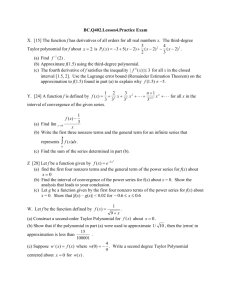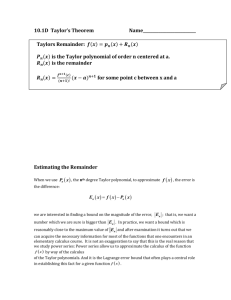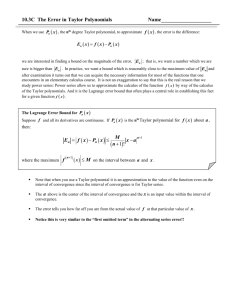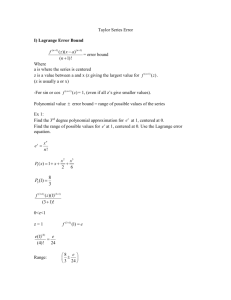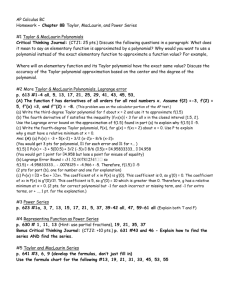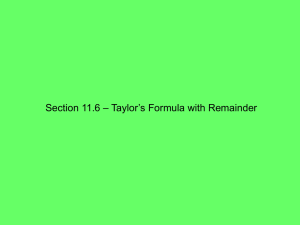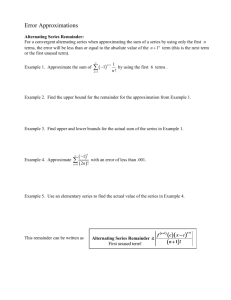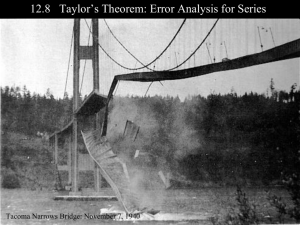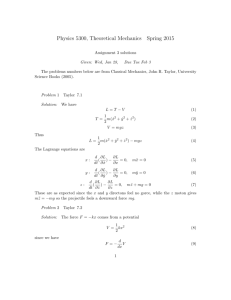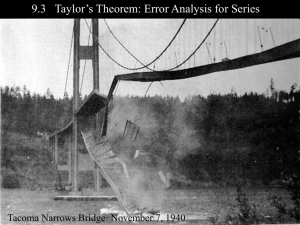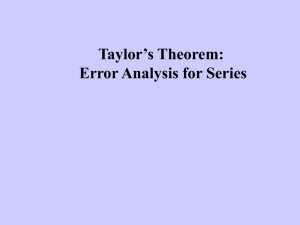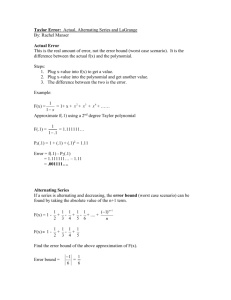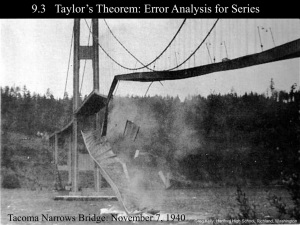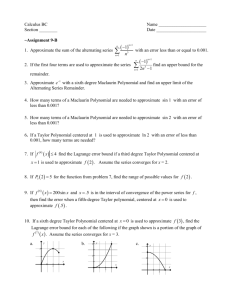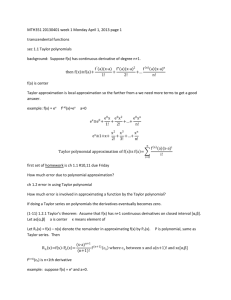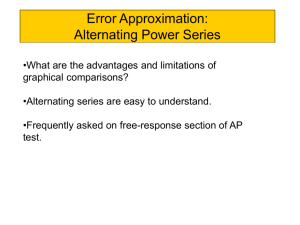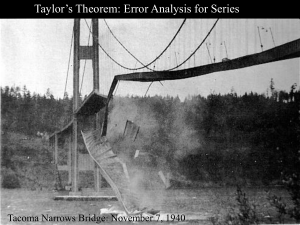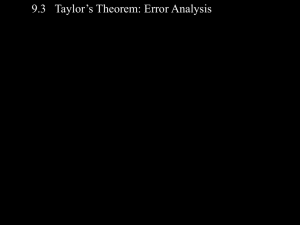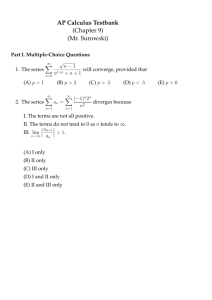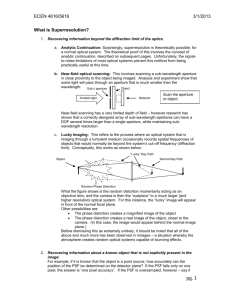Lagrange Error Bound
advertisement
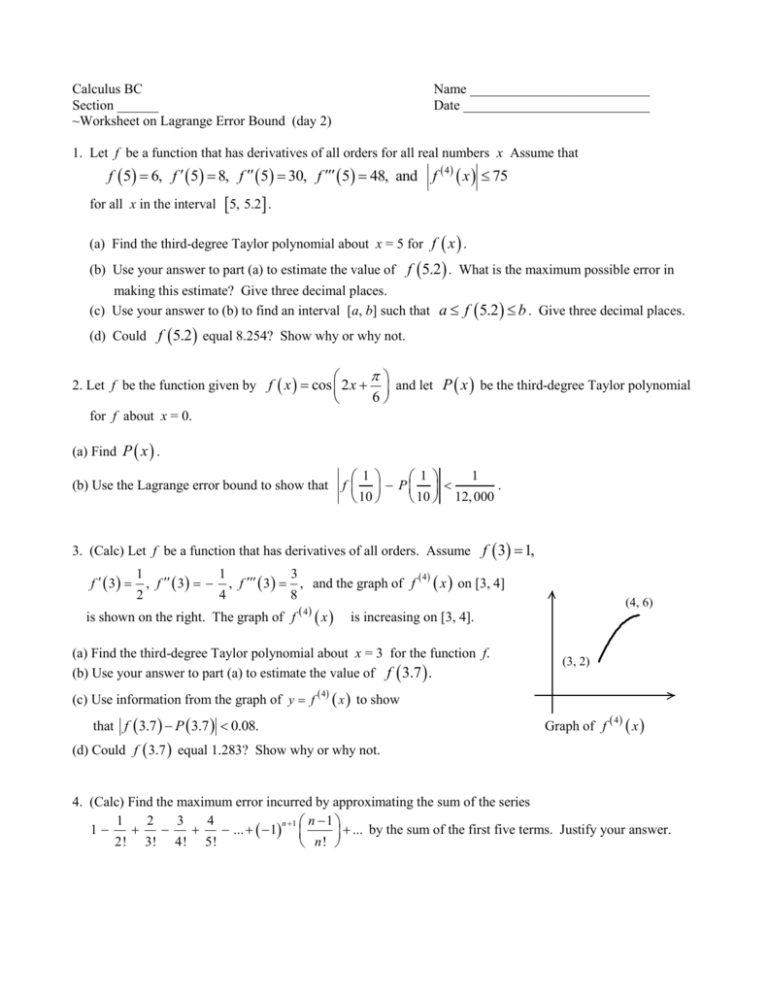
Calculus BC Section ______ ~Worksheet on Lagrange Error Bound (day 2) Name __________________________ Date ___________________________ 1. Let f be a function that has derivatives of all orders for all real numbers x Assume that 4 f 5 6, f 5 8, f 5 30, f 5 48, and f x 75 for all x in the interval 5, 5.2 . (a) Find the third-degree Taylor polynomial about x = 5 for f x . (b) Use your answer to part (a) to estimate the value of f 5.2 . What is the maximum possible error in making this estimate? Give three decimal places. (c) Use your answer to (b) to find an interval [a, b] such that a f 5.2 b . Give three decimal places. (d) Could f 5.2 equal 8.254? Show why or why not. 2. Let f be the function given by f x cos 2 x and let P x be the third-degree Taylor polynomial 6 for f about x = 0. (a) Find P x . 1 1 1 . P 10 10 12, 000 f (b) Use the Lagrange error bound to show that 3. (Calc) Let f be a function that has derivatives of all orders. Assume f 3 1, f 3 1 2 , f 3 3 4 , f 3 , and the graph of f x on [3, 4] 4 8 1 4 is shown on the right. The graph of f x (a) Find the third-degree Taylor polynomial about x = 3 for the function f. (b) Use your answer to part (a) to estimate the value of f 3.7 . (c) Use information from the graph of y f 4 (4, 6) is increasing on [3, 4]. x (3, 2) to show that f 3.7 P 3.7 0.08. 4 Graph of f x (d) Could f 3.7 equal 1.283? Show why or why not. 4. (Calc) Find the maximum error incurred by approximating the sum of the series 1 2 3 4 n 1 n 1 1 ... 1 ... by the sum of the first five terms. Justify your answer. 2! 3! 4! 5! n! 5. Let f be the function given by f x cos 3 x and let P x be the fourth-degree Taylor polynomial 6 for f about x = 0. (a) Find P x . (b) Use the Lagrange error bound to show that 6. Use series to find an estimate for 1 x2 0 e 1 6 1 6 f P 1 3000 . dx so that the error is less than 1 200 . Justify your answer. 7. (Calc) Suppose a function f is approximated with a fourth-degree Taylor polynomial about x = 1. If the 5 maximum value of the fifth derivative between x = 1 and x = 3 is 0.01, that is, f x 0.01 , find the maximum error incurred using this approximation to compute f 3 . Answers to Worksheet on Lagrange Error Bound 1. (a) 6 8 x 5 15 x 5 8 x 5 2 3 (b) f 5.2 P3 5.2 8.264 R3 5.2 0.005 (c) 8.259 f 5.2 8.269 (d) No, f 5.2 can’t equal 8.254 because 8.254 does not lie in the interval found in part (c). 3 2 3 2 4 3 x x x 2 2! 3! 2. (a) 4 1 1 16 24 4 4 1 1 1 1 10 2 5 1 (b) R3 4 4! 4! 5 4! 625 24 15, 000 12, 000 10 3 x 3 x 3 x 3 3. (a) 1 2 4 2! 8 3! 2 (b) 1.310 (c) Since f 4 Error 2 x is increasing on [3, 4], f 4 x 6 on [3, 3.7] so 4 6 3.7 3 0.060 0.08 . 4! (d) Yes, 1.250 f 3.7 1.370 so f 3.7 could equal 1.283. 4. The series has terms that are alternating in sign, decreasing in magnitude, and having a limit of 0 so the error is less than the absolute value of the first truncated term by the Alternating Series Remainder. Error 6th term so Error 5 or 0.012 . 6! 3 3 x 9 3 x 2 27 x3 81 3 x 4 5. (a) P x 2 2 2 2! 2 3! 2 4! f 5 z x 0 (b) R4 x 5! 5 5 243x5 1 1 1 1 243 1 so R4 5 5! 120 32 3000 6 5! 6 5!2 6. The series has terms that are alternating in sign, decreasing in magnitude, and having a limit of 0 so the error is less than the first truncated term by the Alternating Series Remainder. 1 x2 0 e 7. 0.003 dx 1 1 1 1 43 1 1 . Error . 3 10 42 105 216 200
